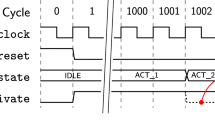Abstract
This paper presents a non-scan design-for-testability method for controllers that are synthesized from FSMs (Finite State Machines). The proposed method can achieve complete fault efficiency: test patterns for a combinational circuit of a controller are applied to the controller using state transitions of the FSM. In the proposed method, at-speed test application can be performed and the test application time is shorter than previous methods. Moreover, experimental results show the area overhead is low.
Similar content being viewed by others
References
H. Fujiwara, Logic Testing and Design for Testability, The MIT Press, 1985.
P.C. Maxwell, R.C. Aitken, V. Johansen, and I. Chiang, “The Effect of Different Test Sets on Quality Level Prediction: When is 80% Better than 90%?,” Proc. of International Test Conference, 1991, pp. 358-364.
V. Chickermane, E.M. Rudnick, P. Banerjee, and J.H. Patel, “Non-Scan Design-For-Testability Techniques for Sequential Circuits,” Proc. of 30th ACM/IEEE Design Automation Conference, 1993, pp. 236-241, 1993.
H. Fujiwara, Y. Nagao, T. Sasao, and K. Kinoshita, “Easily Testable Sequential Machines with Extra Inputs,” IEEE Transaction on Computers, Vol. c-24, No. 8, pp. 821-826, 1975.
S.M. Reddy and R. Dandapani, “Scan Design Using Standard Flip-Flops,” IEEE Design and Test of Computers, Vol. 4, No. 1, pp. 52-54, 1987.
V.D. Agrawal and K.-T. Cheng, “Finite State Machine Synthesis with Embedded Test Function,” Journal of Electronic Testing: Theory and Applications, Vol. 1, pp. 221-228, 1990.
S. Kanjilal, S.T. Chakradhar, and V.D. Agrawal, “Test Function Embedding Algorithms with Application Interconnected Finite State Machines,” IEEE Transaction on Computer-Aided-Design, Vol. 14, No. 9, pp. 1115-1127, 1995.
S.T. Chakradhar, S. Kanjilal, and V.D. Agrawal, “Finite State Machine Synthesis with Fault Tolerant Test Function,” Journal of Electronic Testing: Theory and Applications, Vol. 4, pp. 57-69, 1993.
I. Pomeranz and S.M. Reddy, “Design and Synthesis for Testability of Synchronous Sequential Circuits Based on Strong-Connectivity,” Proc. of International Symposium on Fault-Tolerant Computing, 1993, pp. 492-501.
D. Xiang, S. Venkataraman, W.K. Fuchs, and J.H. Patel, “Partial Scan Design Based on State Information,” Proc. of Design Automation Conference, 1996, pp. 807-812.
D. Xiang and J.H. Patel, “A Global Algorithm for the Partial Scan Design Problem Using Circuit State Information,” Proc. of International Test Conference, 1996, pp. 548-557.
V. Boppana and W.K. Fuchs, “Partial Scan Design Based on State Transition Modeling,” Proc. of International Test Conference, 1996, pp. 538-547.
E.M. Sentovich et al., “SIS: A System for Sequential Circuit Synthesis,” Technical Report UCB/ERL-M92/41, University of California, Berkeley, 1992.
H. Fujiwara and A. Yamamoto, “Parity-Scan Design to Reduce the Cost of Test Application,” IEEE Transaction on Computer-Aided-Design, Vol. 12, No. 10, pp. 1604-1611, 1993.
M. Abramovici, K.B. Rajan, and D.T. Miller, “FREEZE!: A New Approach for Testing Sequential Circuits,” Proc. of Design Automation Conference, 1992, pp. 22-25.
M.R. Garey and D.S. Johnson, Computer and Intractability, W.H. Freeman and Company, 1979.
S. Yang, “Logic Synthesis and Optimization Benchmarks User Guide,” Technical Report 1991-IWLS-UG-Saeyang, Microelectronics Center of North Carolina, 1991.
Rights and permissions
About this article
Cite this article
Ohtake, S., Masuzawa, T. & Fujiwara, H. A Non-Scan Approach to DFT for Controllers Achieving 100% Fault Efficiency. Journal of Electronic Testing 16, 553–566 (2000). https://doi.org/10.1023/A:1008333102734
Issue Date:
DOI: https://doi.org/10.1023/A:1008333102734




